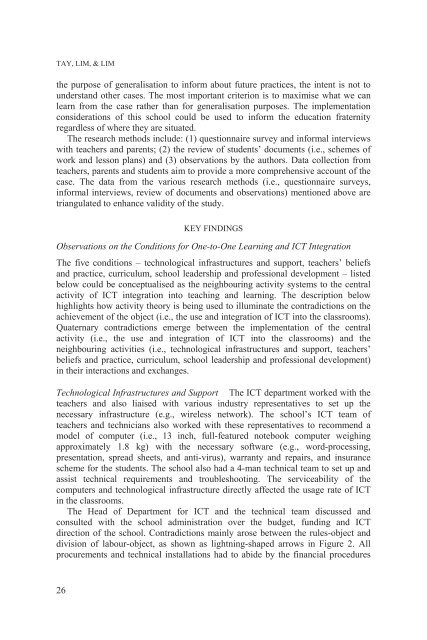1517-creating-holistic-technology-enhanced-learning-experiences
1517-creating-holistic-technology-enhanced-learning-experiences
1517-creating-holistic-technology-enhanced-learning-experiences
You also want an ePaper? Increase the reach of your titles
YUMPU automatically turns print PDFs into web optimized ePapers that Google loves.
TAY, LIM, & LIM<br />
the purpose of generalisation to inform about future practices, the intent is not to<br />
understand other cases. The most important criterion is to maximise what we can<br />
learn from the case rather than for generalisation purposes. The implementation<br />
considerations of this school could be used to inform the education fraternity<br />
regardless of where they are situated.<br />
The research methods include: (1) questionnaire survey and informal interviews<br />
with teachers and parents; (2) the review of students’ documents (i.e., schemes of<br />
work and lesson plans) and (3) observations by the authors. Data collection from<br />
teachers, parents and students aim to provide a more comprehensive account of the<br />
case. The data from the various research methods (i.e., questionnaire surveys,<br />
informal interviews, review of documents and observations) mentioned above are<br />
triangulated to enhance validity of the study.<br />
26<br />
KEY FINDINGS<br />
Observations on the Conditions for One-to-One Learning and ICT Integration<br />
The five conditions – technological infrastructures and support, teachers’ beliefs<br />
and practice, curriculum, school leadership and professional development – listed<br />
below could be conceptualised as the neighbouring activity systems to the central<br />
activity of ICT integration into teaching and <strong>learning</strong>. The description below<br />
highlights how activity theory is being used to illuminate the contradictions on the<br />
achievement of the object (i.e., the use and integration of ICT into the classrooms).<br />
Quaternary contradictions emerge between the implementation of the central<br />
activity (i.e., the use and integration of ICT into the classrooms) and the<br />
neighbouring activities (i.e., technological infrastructures and support, teachers’<br />
beliefs and practice, curriculum, school leadership and professional development)<br />
in their interactions and exchanges.<br />
Technological Infrastructures and Support The ICT department worked with the<br />
teachers and also liaised with various industry representatives to set up the<br />
necessary infrastructure (e.g., wireless network). The school’s ICT team of<br />
teachers and technicians also worked with these representatives to recommend a<br />
model of computer (i.e., 13 inch, full-featured notebook computer weighing<br />
approximately 1.8 kg) with the necessary software (e.g., word-processing,<br />
presentation, spread sheets, and anti-virus), warranty and repairs, and insurance<br />
scheme for the students. The school also had a 4-man technical team to set up and<br />
assist technical requirements and troubleshooting. The serviceability of the<br />
computers and technological infrastructure directly affected the usage rate of ICT<br />
in the classrooms.<br />
The Head of Department for ICT and the technical team discussed and<br />
consulted with the school administration over the budget, funding and ICT<br />
direction of the school. Contradictions mainly arose between the rules-object and<br />
division of labour-object, as shown as lightning-shaped arrows in Figure 2. All<br />
procurements and technical installations had to abide by the financial procedures


